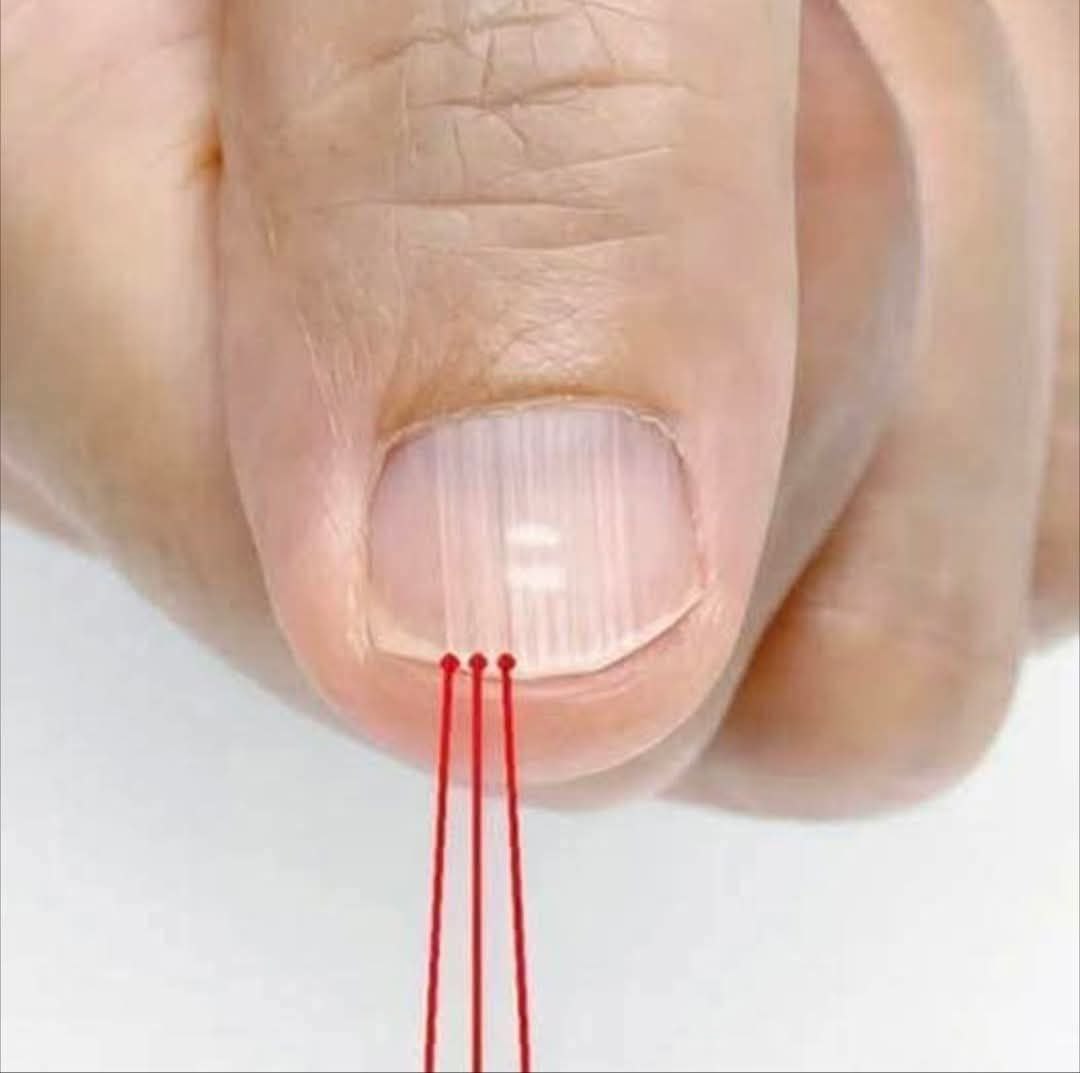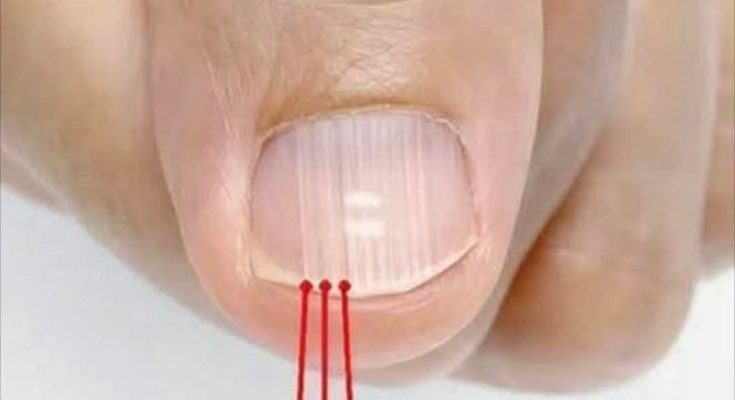If you have these lines on your nails it’s a clear sign…See more

Manicures will cover any ripples or bumps on your nails, but shiny polish can’t hide the disease that might be hiding inside your body.
Your nails reflect your overall health and any abnormalities can suggest there’s a potential problem with your liver, lungs or heart.
Nail health is often a mirror of what’s happening inside our bodies and when changes occur, it may signal various health conditions or simply reflect normal aging processes.
Stripes on nails can be harmless, but according to the National Library of Medicine (NCBI), ridges on “nails may also provide an insight into more sinister systemic manifestations,” indicating underlying health issues.
In this article, we’ll explore the different types of stripes on your nails, what they might mean and when you should consider seeking medical advice.
Types of Nail Stripes
Vertical Stripes
Vertical stripes, or longitudinal striations, are common and typically run from the cuticle to the tip. They are often associated with aging, as nail ridges can become more prominent with age.
In some cases, they may reflect nutritional deficiencies, such as a lack of certain minerals or vitamins (vitamin B12, magnesium, or iron).
Vertical ridges are common with aging and are often harmless. However, if they appear suddenly or become more pronounced, it may be worth checking for conditions like anemia or thyroid issues.
Horizontal Stripes
Horizontal stripes or grooves may indicate more specific health concerns.
Also called Beau’s lines, these horizontal indentations can appear after physical trauma to the nail, or from serious illnesses or medical conditions, including malnutrition, uncontrolled diabetes, heart attacks or respiratory diseases.
The appearance of these ridges is often associated with temporary disruptions in nail growth caused by periods of intense stress or illness, as the body may temporarily slow down or halt nail growth.
The NCBI writes that if growth of the grooves is “abrupt, [it] indicates a sudden attack of disease.” And, when present on all 20 nails, it’s “usually the result of systemic disease such as mumps, pneumonia, coronary thrombosis, Kawasaki disease, syphilis, and hypoparathyroidism.”
White Stripes
White, parallel horizontal lines that do not indent the nail surface may indicate liver or kidney issues. These lines, called Muehrcke’s lines, tend to fade temporarily when the nail is pressed and often appear on multiple nails simultaneously.
A decrease in blood protein levels, particularly albumin, can also cause these white stripes, commonly seen in those with malnutrition or chronic liver disease.
If Muehrcke’s lines are visible on multiple nails, consult with a medical professional as it may be a sign of protein deficiencies or kidney/liver problems.
‘Poor diet’
For the majority of the population, ripples are normal and can be fixed with some buffing or a healthy lifestyle change.
A balanced diet that’s rich in protein, vitamins and minerals – biotin, vitamin E, iron and zinc – can improve nail appearance over time.
Dr. Sara Norris, a naturopathic doctor based in Los Angeles, tells Healthline that “nail health is most often an indicator of poor nutritional intake or poor digestion.”
“Brittle, weak, and peeling nails are the most common concerns I see in my practice, and these symptoms are more often the result of a poor diet than of systemic disease,” she explains.
Your nails are offering you some valuable insights into your health, ranging from harmless signs of aging to potential indicators of underlying health conditions. Most causes are easy to treat but they’re a good indicator of poor health so pay attention to what they’re telling you!
Striped Nails and What They Might Reveal About Your Health: A Detailed Guide
Our nails can serve as more than just a canvas for nail polish—they are often a window into the state of our overall health. Subtle changes in the appearance of your nails can indicate the presence of underlying conditions in the body, ranging from simple nutritional deficiencies to more serious health concerns. One of the most common and noticeable changes in nails is the appearance of stripes or ridges. These stripes can vary in color, texture, and orientation, and understanding what they mean can provide valuable insights into your health.
In this article, we’ll explore the various types of nail stripes, what they might indicate about your body, and when you should seek medical advice.
Types of Nail Stripes: Understanding the Different Patterns
1. Vertical Stripes: Aging, Nutritional Deficiencies, or Thyroid Issues?
Vertical stripes, also known as longitudinal striations, run from the cuticle to the tip of the nail. They are common and, in many cases, are associated with the natural aging process. As we age, our body’s ability to regenerate cells, including those in the nails, slows down, leading to the formation of vertical ridges.
However, vertical stripes can also be a signal that something more might be going on inside the body. Nutritional deficiencies are one of the most common reasons for the appearance of these ridges. For example, a lack of vitamin B12, magnesium, or iron can cause changes to your nails, making the ridges more pronounced.
When to worry:
- Sudden appearance of ridges: If vertical ridges appear suddenly or become more pronounced, this could point to underlying health issues such as anemia, where iron levels in the body are low, or hypothyroidism, where the thyroid is underactive and affects many aspects of your health, including nail growth.
- Persistent or worsening ridges: If your ridges become deeper or your nails begin to feel brittle and weak, it’s important to check for nutritional deficiencies or thyroid disorders.
How to address it:
- If the ridges are due to aging, no treatment is necessary, but maintaining a healthy diet can help keep nails strong.
- For those with nutritional deficiencies, iron, magnesium, and vitamin B12 supplements or dietary changes may help improve the appearance of nails over time. Regular blood tests can determine if you have any vitamin or mineral deficiencies.
2. Horizontal Stripes: What Are Beau’s Lines Telling You?
Horizontal stripes, often referred to as Beau’s lines, run across the nail rather than from top to bottom. These lines can appear due to a temporary halt in nail growth caused by illness or trauma to the body. Beau’s lines are usually deep and clearly visible and can be a sign of serious systemic diseases or acute conditions that have disrupted the normal function of the body.
- Causes of Beau’s Lines:
- Trauma to the Nail: Physical injury or damage to the nail can interrupt its growth, leading to the formation of horizontal grooves.
- Illness or Infection: A serious infection or illness, such as malnutrition, diabetes, or heart conditions, can also cause Beau’s lines. The lines often develop after the body has been under physical stress due to illness or surgery, as the body may temporarily redirect its energy away from non-essential processes like nail growth.
- Severe conditions: Diseases like mumps, pneumonia, syphilis, and even conditions like hypoparathyroidism or Kawasaki disease have been associated with the development of Beau’s lines.
When to worry:
- New and sudden appearance of horizontal stripes on all nails can indicate a serious illness or disease that disrupted the body’s ability to produce healthy nails.
- Consult a doctor if you notice these lines after an episode of severe illness or if they appear along with other unexplained symptoms, such as fever or significant weight loss.
How to address it:
- Treatment will vary based on the underlying condition. For example, if Beau’s lines are caused by malnutrition, nutritional adjustments or supplements may help. If they result from an infection or illness, treating the primary health issue will allow the nails to recover.
3. White Stripes: Muehrcke’s Lines and Liver/Kidney Health
White, horizontal stripes that do not indent the nail but instead appear as a faint, parallel line are known as Muehrcke’s lines. Unlike Beau’s lines, these stripes do not cause the nail to dip or groove but rather manifest as a white discoloration of the nail bed.
Causes of Muehrcke’s Lines:
- Liver Disease: Muehrcke’s lines are often seen in individuals suffering from liver disease, particularly conditions like cirrhosis or hepatitis. The lines may also appear in those with chronic kidney disease.
- Protein Deficiency: A decrease in blood protein levels, particularly albumin, often caused by malnutrition or liver disease, can contribute to the development of Muehrcke’s lines.
- Chronic Illness: Conditions that reduce the body’s ability to absorb nutrients or manage waste, such as chronic kidney disease, can also lead to the appearance of these lines.
When to worry:
- If white parallel lines appear across multiple nails, it could be a sign of liver or kidney issues. These lines should not be ignored, especially if other symptoms of liver or kidney dysfunction are present, such as fatigue, swelling, jaundice (yellowing of the skin or eyes), or changes in urination.
How to address it:
- Consult a healthcare provider to check for liver or kidney function through blood tests. Treatment will depend on the underlying condition, whether it’s liver disease, kidney dysfunction, or a deficiency in proteins or nutrients.
4. Other Nail Health Concerns:
While stripes are a key indicator of internal health issues, other nail abnormalities can also signal problems in the body. These include:
- Brittle, peeling, or splitting nails: Often a sign of nutritional deficiencies (e.g., biotin, vitamin E, or zinc) or dehydration.
- Pitted nails: Small, deep indentations on the surface of nails are often associated with psoriasis, an autoimmune disease, or alopecia areata, an autoimmune condition that causes hair loss.
- Discolored nails: Yellowing of the nails can indicate a fungal infection, but if the discoloration is accompanied by other symptoms, it could also point to more serious issues like lung disease or diabetes.
- Clubbing: If the tips of your fingers or toes become swollen and round, it could be a sign of heart disease, lung disease, or even digestive disorders like Crohn’s disease.
What Should You Do If You Notice Stripes on Your Nails?
If you notice any significant changes to the appearance of your nails, it’s important not to panic but to observe the changes closely. Here’s what you can do:
- Track the Changes: Take note of when the stripes first appeared, if they have changed in any way, and whether they are affecting multiple nails.
- Consult a Doctor: If the stripes are accompanied by other symptoms (fatigue, jaundice, weight loss, or shortness of breath) or if the stripes appear suddenly and are severe, consult a healthcare provider. They may suggest blood tests, nutritional assessments, or other diagnostic tests to determine the cause.
- Improve Your Diet: If the stripes are due to nutritional deficiencies, a balanced diet rich in vitamins, minerals, and protein can help improve nail health over time.
- Monitor Nail Growth: Once the underlying issue is treated, your nails may begin to grow out and heal. It can take a few months for the new nails to fully replace the damaged ones, so be patient.
Conclusion: Pay Attention to Your Nails
Your nails provide valuable clues about your overall health. While stripes can sometimes be a sign of harmless aging, they can also point to more serious systemic issues. Whether it’s vitamin deficiencies, liver problems, heart disease, or other health conditions, paying attention to changes in your nails can give you a head start in addressing potential health concerns. Remember, your nails are telling you something—don’t ignore the signs!
